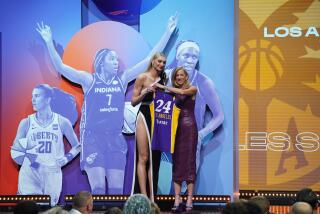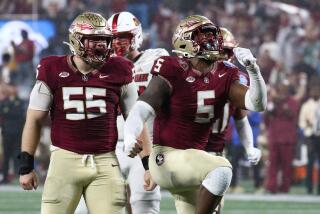It Was a Good Draft for Redskins
- Share via
The Washington Redskins believe this might be the kind of draft class that coaches and general managers dream about. The kind of draft class that gives a franchise a supply of fresh legs and a burst of enthusiasm. The kind that can provide a team with a core of talent for a decade.
At least, that’s what the Redskins hope as they prepare to open the 1997 regular season Sunday night at Carolina.
For the first time in at least three decades, the Redskins have kept all of their draft choices on their roster.
They’ll open the season with nine rookies -- eight draft choices and undrafted free agent wide receiver James Thrash. Two other players -- second-year tight end Chris Sanders and second-year defensive end Kelvin Kinney -- will suit up for an NFL game for the first time Sunday.
“When the scouts left training camp, I told them they should be proud of the job they did,” General Manager Charley Casserly said. “This is as good a draft as anybody in the league had this year.”
At no time in recent history -- at least since 1970 -- have the Redskins kept so many rookies on their active roster. Three -- defensive end Kenard Lang, linebacker Derek Smith and guard Brad Badger -- will start against the Panthers, and at least one other -- safety Jamel Williams -- could have a role on passing downs.
Casserly has been criticized in recent years because the Redskins have missed on so many recent first-round draft choices: quarterback Heath Shuler (1994), wide receiver Desmond Howard (1992), defensive tackle Bobby Wilson (1991) and tackle Andre Johnson (1996), who was cut Sunday.
However, Casserly -- and Coach Norv Turner, who arrived in 1994 -- also have used the draft to restock a roster that had gotten old. While missing on the first-rounders, they found quarterback Gus Frerotte in the seventh round in 1994. They used other lower-round picks on Tre Johnson, Joe Patton, Cory Raymer, Darryl Pounds, Jamie Asher, Scott Turner, Stephen Davis, Lemont Evans and Kinney.
“People focus on one pick,” Casserly said. “I’m not saying we couldn’t have done a better job on some of our first-rounders. We could have. But the fact is that 17 of the last 22 players we’ve drafted are on this club. And there’s Scott Blanton, Matt Turk, Patrise Alexander, Larry Bowie, James Thrash, Chris Sanders and Brian Walker. Those are undrafted guys we signed after the draft. Some of those guys turn out to be just as important as the draft picks.
“Look at the big picture. What’s the objective? It’s to win the Super Bowl. Where was this team three years ago, and where is this team today? Do we have a better team now than before we ripped the thing apart? We cut some players who are going to end up playing for other teams.”
This season of optimism is based on an offense that has depth and experience and on a defense that has been rebuilt with a new coaching staff and five new starters. But the rookies could make a difference this season because they add enthusiasm during practice and increase competition for jobs.
First-round draft choice Kenard Lang has been as good as advertised, a big, strong force who had terrific coaching at the University of Miami and seems ready to contribute.
The other top choices -- second-rounder Greg Jones, third-rounder Derek Smith and wide receiver Albert Connell -- have also been as good as coaches hoped. Smith will start, and Jones and Connell will have backup roles. All three appear to have bright futures.
Where the Redskins cleaned up was with their four fifth-round choices: safety Jamel Williams, cornerback Keith Thibodeaux, linebacker Twan Russell and guard Brad Badger. They’ve all had solid camps. Badger will start the opener, and Williams will play on some passing downs.
“Some guys make it on what you think they’ll do next year,” Casserly said. “These guys made it on what they did in this camp. We cut players that would have made our team in other years.”
As for the players, they’ve survived a training camp when they had longer practices and more meetings than they ever imagined. Asked what he did after hours during camp, Russell said: “We were in meetings until 10 at night. By then, it was time to go to sleep.”
More to Read
Go beyond the scoreboard
Get the latest on L.A.'s teams in the daily Sports Report newsletter.
You may occasionally receive promotional content from the Los Angeles Times.










